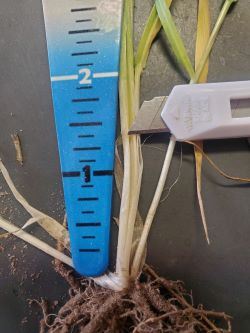Late Spring Freeze on Wheat
Apr 13, 2020

Mother nature really decided to keep us on our toes this Spring. From 85 degrees on Saturday, April 11th to a low of 25 degrees on Sunday night/Monday morning, these temperature swings can be hard on people, crops, and animals. Late spring freeze injury on wheat is fairly common in Kansas. However, its always hard to see extremely low temperatures on the thermometer when we have our wheat looking so good.
How much damage can we expect to see to the wheat? This is always the question we get right after a hard freeze. Many factors can influence the level of damage – plant growth stage, plant moisture content, duration of exposure, plant stand density, and precipitation to name a few. Elevation variances throughout a field can also affect the level of damage. Because there are so many key factors, it can be hard to make a general statement about the extent of damage across an area.
After sampling several fields this morning, it appears that many fields had the growing point above the soil surface by ¾”- 1 ½” on the main stem - meaning the growing point was not protected by the soil at the time of the freeze. Tillers whose growing point was closer to ground level will likely show less damage in the long term. Ground temperature this morning in wheat fields was 38-40 degrees at 2 inches deep.
It will likely be 10-14 days before we know the full extent of damage from last night’s freeze. In the next two weeks, here are a few things to look for:
How much damage can we expect to see to the wheat? This is always the question we get right after a hard freeze. Many factors can influence the level of damage – plant growth stage, plant moisture content, duration of exposure, plant stand density, and precipitation to name a few. Elevation variances throughout a field can also affect the level of damage. Because there are so many key factors, it can be hard to make a general statement about the extent of damage across an area.
After sampling several fields this morning, it appears that many fields had the growing point above the soil surface by ¾”- 1 ½” on the main stem - meaning the growing point was not protected by the soil at the time of the freeze. Tillers whose growing point was closer to ground level will likely show less damage in the long term. Ground temperature this morning in wheat fields was 38-40 degrees at 2 inches deep.
It will likely be 10-14 days before we know the full extent of damage from last night’s freeze. In the next two weeks, here are a few things to look for:
- Split stems and check the color of the growing point – This can be found just above the first extended node and should be a bright white color. Injury will cause the growing point to be off-white or brown.
- Look for a dead or chlorotic leaf in the whorl – this indicates a damaged growing point. These tillers will also stop growing as soon as the growing point is damaged.
- Injury to the lower stems – chlorotic coloring and lesions